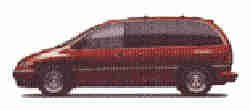Vans and mini-vans
Vans are a category of trucks. They're often built on a truck chassis, with heavy-duty construction and suspension. Passenger vans can seat six to 15 people, while cargo vans have lots of open room for hauling goods or work materials. The extra size of a van can mean increased efficiency in moving people and cargo. That's why many transportation agencies encourage commuters to use "van-pools". Mini-vans: Introduced in the mid-1980's, these vehicles have become standard features on the American highway. Consumers buy more than 1.1 million mini-vans each year. A "mini-van" is just that -- a smaller version of the traditional van. Mini-vans have become a popular choice for many motorists, replacing the station wagon for many families, and also used by many small businesses and other groups. Mini-vans come in both cargo and passenger configurations (usually 6-7 people), and often have removable seats for mixed use. The driver sits high (as in a pickup) and the vehicle is of moderate length, which makes mini-vans relatively easy to drive. Mini-vans have excellent safety records, too, due in part to their size and weight. New models offer enhanced safety features, including air bags, anti-lock brakes and side-impact protection, which provide even greater safety. Most mini-vans have FWD, for improved fuel economy, while others offer RWD or 4WD for greater hauling power. Fuel economy ratings are slightly lower than cars, but these vehicles often save fuel by carrying more people.
Standard vans: The "traditional" vans are built for larger loads (people or cargo), and they continue to grow in popularity. Full-size passenger vans usually seat 8-15 people, and are used in commuter "van-pools" and as para-transit or shuttle vehicles. Full-size cargo vans provide up to 160 cu. ft. of space, useful for service and delivery vehicles; and many models are available with stronger engines and suspension, for hauling heavier equipment. Vans are built with RWD, to permit hauling and towing of heavy loads. Vans and van chassis are also used to develop a variety of special custom vehicles (such as campers, ambulances) with larger frames and bodies. Regular vans may not provide as much interior comfort as mini-vans or cars, but they're capable of moving greater loads. They provide good safety protection, because of their size and weight. Fuel economy ratings are somewhat lower (especially on heavy-duty lines), as with full-size trucks, but they're doing more work. Passenger vans can take the place of several car trips, thus saving fuel, cutting emissions and reducing congestion.
Conversion vans: One of the most popular form of recreational vehicles (RV's), these are vans (usually standard-sized) specially modified for use by travelers and vacationers. Many offer built-in cooking and sleeping facilities, as well as comfortable chairs and other amenities. RV's have made long-distance travel more affordable for millions of Americans! Federal standards: Here's what the government requires on vans, mini-vans and other light trucks:
|
| CVC
home page |
Back to last page |
Top of this page |
This page last
updated: 7/5/99 |
 DO YOU DRIVE a mini-van? Know someone who
owns an RV? Ever notice the delivery and service vans in your community?
Vans come in many different sizes and models -- some built for people,
some for cargo, some for both -- and they're increasingly popular on
American highways, accounting for 1 in 10 of new vehicles sold.
DO YOU DRIVE a mini-van? Know someone who
owns an RV? Ever notice the delivery and service vans in your community?
Vans come in many different sizes and models -- some built for people,
some for cargo, some for both -- and they're increasingly popular on
American highways, accounting for 1 in 10 of new vehicles sold.